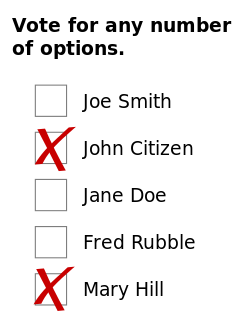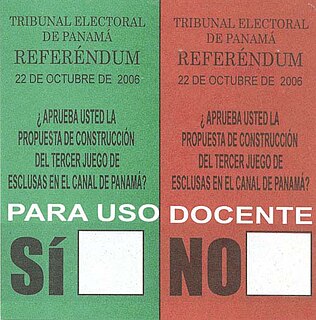
Approval voting is an electoral system where each voter may select ("approve") any number of candidates, and the winner is the candidate approved by the largest number of voters. It is distinct from plurality voting, in which a voter may choose only one option among several, whereby the option with the most votes is chosen. It is related to score voting in which voters give each option a score on a scale, and the option with the highest total of scores is selected. Approval voting can also be used in multiwinner elections; see multiwinner approval voting.

An election is a formal group decision-making process by which a population chooses an individual or multiple individuals to hold public office.
Proportional representation (PR) characterizes electoral systems in which divisions in an electorate are reflected proportionately in the elected body. The concept applies mainly to geographical and political divisions of the electorate. For instance in the European parliament, each member state has a number of seats that is (roughly) proportional to its population, enabling geographical proportional representation. Almost all European countries also have political proportional representation : When n% of the electorate support a particular political party or set of candidates as their favorite, then roughly n% of seats are allotted to that party or those candidates. The essence of such systems is that all votes contribute to the result—not just a plurality, or a bare majority. The most prevalent forms of proportional representation all require the use of multiple-member voting districts, as it is not possible to fill a single seat in a proportional manner. In fact, PR systems that achieve the highest levels of proportionality tend to include districts with large numbers of seats, as large as a province or an entire nation.
Score voting or range voting is an electoral system for single-seat elections, in which voters give each candidate a score, the scores are added, and the candidate with the highest total is elected. It has been described by various other names including evaluative voting, utilitarian voting, interval measure voting, the point system, ratings summation, 0-99 voting, average voting and utilityvoting. It is a type of cardinal voting electoral system, and aims to implement the utilitarian social choice rule.

The two-round system is a voting method used to elect a single candidate, where voters cast a single vote for their preferred candidate. The election proceeds to a second round only if in the first round no candidate has received a simple majority of votes cast, or at least some other prescribed percentage. In the second round, usually only the two candidates who received the most votes in the first round, or those candidates who received above a prescribed proportion of the votes, would be candidates in the second round. Any remaining candidate is free to withdraw from the second round.

The single transferable vote (STV) is a voting system designed to achieve or closely approach proportional representation through the use of multiple-member constituencies and each voter casting a single ballot on which candidates are ranked. The preferential (ranked) balloting allows transfer of votes to produce proportionality, to form consensus behind select candidates and to avoid the waste of votes prevalent under other voting systems. Another name for STV is multi-winner ranked-choice voting.
In voting methods, tactical voting occurs in elections with more than two candidates, when a voter supports another candidate more strongly than their sincere preference in order to prevent an undesirable outcome.

Voting is a method for a group, such as a meeting or an electorate, in order to make a collective decision or express an opinion usually following discussions, debates or election campaigns. Democracies elect holders of high office by voting. Residents of a place represented by an elected official are called "constituents", and those constituents who cast a ballot for their chosen candidate are called "voters". There are different systems for collecting votes, but while many of the systems used in decision-making can also be used as electoral systems, any which cater for proportional representation can only be used in elections.

The Australian electoral system comprises the laws and processes used for the election of members of the Australian Parliament. The system presently has a number of distinctive features including compulsory enrolment, compulsory voting, majority-preferential instant-runoff voting in single-member seats to elect the lower house, the House of Representatives, and the use of the single transferable vote proportional representation system to elect the upper house, the Senate.
"None of the above", or NOTA for short, also known as "against all" or a "scratch" vote, is a ballot option in some jurisdictions or organizations, designed to allow the voter to indicate disapproval of the candidates in a voting system. It is based on the principle that consent requires the ability to withhold consent in an election, just as they can by voting "No" on ballot questions.
In single-winner voting system theory, the Condorcet loser criterion (CLC) is a measure for differentiating voting systems. It implies the majority loser criterion.
Instant-runoff voting (IRV), also sometimes referred to as the alternative vote (AV), preferential voting, or, in the United States, ranked-choice voting (RCV), though these names are also used for other systems, is a type of ranked preferential voting counting method used in single-seat elections with more than two candidates.

An electoral system or voting system is a set of rules that determine how elections and referendums are conducted and how their results are determined. Political electoral systems are organized by governments, while non-political elections may take place in business, non-profit organisations and informal organisations. These rules govern all aspects of the voting process: when elections occur, who is allowed to vote, who can stand as a candidate, how ballots are marked and cast, how the ballots are counted, how votes translate into the election outcome, limits on campaign spending, and other factors that can affect the result. Political electoral systems are defined by constitutions and electoral laws, are typically conducted by election commissions, and can use multiple types of elections for different offices.

Cardinal voting refers to any electoral system which allows the voter to give each candidate an independent evaluation, typically a rating or grade. These are also referred to as "rated", "evaluative", "graded", or "absolute" voting systems. Cardinal methods and ordinal methods are two main categories of modern voting systems, along with plurality voting.
Ranked voting, also known as ranked-choice voting or preferential voting, is any election voting system in which voters use a ranked ballot to select more than one candidate and to rank these choices in a sequence on the ordinal scale of 1st, 2nd, 3rd, etc. There are multiple ways in which the rankings can be counted to determine which candidate or candidates is or are elected, and these different methods may produce different results from the same set of ballots. Ranked voting is different from cardinal voting, where candidates are independently rated, rather than ranked.
A unified primary is an electoral system for narrowing the field of candidates for a single-winner general election, similar to a nonpartisan blanket primary, but using approval voting for the first round.
Electoral systems are the rules for conducting elections. Comparisons between different systems can focus on different aspects: on suffrage or rules for voter eligibility; on candidate eligibility and the rules governing political parties; on the way elections are scheduled, sequenced, and combined; or on the rules for determining the winner within a given election.
D21 – Janeček method is an electoral system created by Czech mathematician Karel Janeček. D21 – Janeček method is a modern voting and electoral method. Its main advantage is an effect of multiple votes which enables casting multiple plus votes, and in certain cases, also a minus vote. Multiple votes enable us to express a wider scope of preferences, thereby reflecting the complexities of social choice more accurately. The system was developed ostensibly in response to corruption within the Czech political system. Though it has not yet been used in any general elections, D21 has found use in several participatory budgeting programs conducted by cities and countries around the world, including the New York City. The game Prezident 21 was introduced in 2016 in order to help familiarize people with the D21 system.
Combined approval voting (CAV) is an electoral system where each voter may express approval, disapproval, or indifference toward each candidate. The winner is the most-approved candidate.
STAR voting is an electoral system for single-seat elections. Variations also exist for multi-winner and proportional representation elections. The name stands for "Score then Automatic Runoff", referring to the fact that this system is a combination of Score voting, to pick two finalists with the highest total scores, followed by a "virtual runoff" in which the finalist who is preferred on more ballots wins. It is a type of cardinal voting electoral system.







